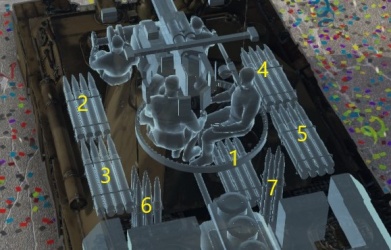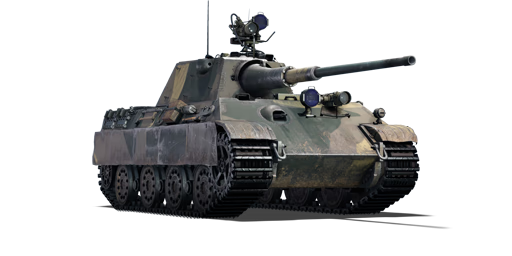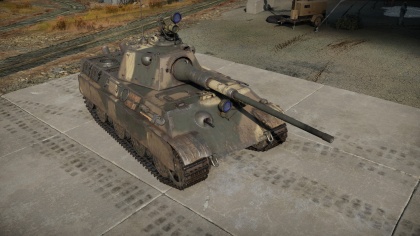Panther II
Contents
| This page is about the German medium tank Panther II. For other tanks of the family, see Panther tank (Family). For other uses, see Panther (Disambiguation). |
Description
The Pz.Kpfw. Panther II is a rank IV German medium tank
with a battle rating of 7.0 (AB/RB/SB). It was introduced during the Closed Beta Test for Ground Forces before Update 1.41 as a main tree vehicle, however, as of Update 1.91 "Night Vision" it was shifted to become a gift vehicle for players who previously owned it.
General info
Survivability and armour
- Rolled homogeneous armour
- Cast homogeneous armour (Gun mantlet, Cupola)
| Armour | Front(Slope angle) | Sides(Slope angle) | Rear(Slope angle) | Roof |
|---|---|---|---|---|
| Hull | 100 mm(55-56°) Front plate
60 mm(50°) Lower glacis |
60 mm(30°) Top
60 mm(0°) Bottom |
40 mm(29-33°) | 30 mm |
| Turret | 120 mm(20-21°)Turret front
300 mm Gun Mantlet |
60 mm(25) | 60 mm(25°) | 30 mm |
| Armour | Sides | Roof | ||
| Cupola | 100 mm | 30 mm |
- Part of the hull's sides are added with 5 mm plating as additional protection against explosive warhead
- Tracks are 20 mm thick
- Each wheel is 20 mm thick
- Part of the hull is covered by tracks, adding additional 20 mm of armour
- Gun barrel is 20 mm thick
The armour on this variant is the same as the armour on the Panther F. Although sufficient to protect against most small-calibre guns, it won't hold up when facing higher calibre guns such as the M3 (90 mm), D-25T (122 mm) and 20pdr OQF Mk.I (84 mm) that it will likely meet at its rank. The best tactic to survive is to not get hit by an enemy attacker, as the crew is quite cramped and will typically be disabled with one well-placed shot.
Mobility
| Game Mode | Max Speed (km/h) | Weight (tons) | Engine power (horsepower) | Power-to-weight ratio (hp/ton) | |||
|---|---|---|---|---|---|---|---|
| Forward | Reverse | Stock | Upgraded | Stock | Upgraded | ||
| Arcade | 60 | 16 | 53 | 1395 | 1,717 | 26.32 | 32.4 |
| Realistic | 54 | 15 | 796 | 900 | 15.02 | 16.98 | |
As with all Panthers, this tank has excellent mobility both on and off road. One notable difference between the Panther II and the other Panthers is its reverse speed. Comparing to a max -4 km/h reverse speed on the rest of the Panthers, the Panther II provides a -12 km/h reverse speed, which can help a lot in battles.
Armaments
Main armament
The Panther II boasts the excellent 88 mm KwK 43 with its notably punchy PzGr 39/43 shell, with a reload speed comparable to that of the Tiger II. Thus, it represents a threat for every tank on the battlefield, even at long ranges. Its rather poor gun handling, however (7.1°/s turret rotation on a stock tank with a level 1 crew) means close-quarters engagements and particularly urban combat should be avoided if possible. This can be somewhat remedied by its ability to neutral steer to acquire a firing solution faster. The optimal ammo loadout is 15 rounds, since it eliminates the ammo racks at the sides of the hull, while still providing a decent quantity of ammunition. It is not recommended to load anything other than PzGr 39/43 shells since it can readily hull break most opponents that have such a feature and it provides consistent ballistic characteristics, while still maintaining a fairly good penetration against sloped armour.
| 88 mm KwK43 | Turret rotation speed (°/s) | Reloading rate (seconds) | |||||||||||
|---|---|---|---|---|---|---|---|---|---|---|---|---|---|
| Mode | Capacity | Vertical | Horizontal | Stabilizer | Stock | Upgraded | Full | Expert | Aced | Stock | Full | Expert | Aced |
| Arcade | 50 | -8°/+15° | ±180° | N/A | 11.4 | 15.7 | __._ | __._ | __._ | 11.1 | __.__ | __.__ | 8.5 |
| Realistic | 7.1 | 8.4 | __._ | __._ | 12.0 | ||||||||
Ammunition
| Penetration statistics | |||||||
|---|---|---|---|---|---|---|---|
| Ammunition | Type of warhead |
Penetration @ 0° Angle of Attack (mm) | |||||
| 10 m | 100 m | 500 m | 1,000 m | 1,500 m | 2,000 m | ||
| Hl.Gr 39 | HEAT | 110 | 110 | 110 | 110 | 110 | 110 |
| PzGr 39/43 | APCBC | 237 | 234 | 222 | 207 | 194 | 181 |
| PzGr 40/43 | APCR | 279 | 273 | 252 | 227 | 205 | 185 |
| Sprgr.43 | HE | 14 | 14 | 14 | 14 | 14 | 14 |
| Shell details | ||||||||||
|---|---|---|---|---|---|---|---|---|---|---|
| Ammunition | Type of warhead |
Velocity (m/s) |
Projectile Mass (kg) |
Fuse delay (m) |
Fuse sensitivity (mm) |
Explosive Mass (TNT equivalent) (g) |
Normalisation at 30° from horizontal |
Ricochet | ||
| 0% | 50% | 100% | ||||||||
| Hl.Gr 39 | HEAT | 600 | 7.64 | N/A | 0.3 | 1,098 | +0.0° | 62° | 69° | 73° |
| PzGr 39/43 | APCBC | 1,000 | 10.16 | 1.2 | 14.0 | 108.8 | +4.0° | 48° | 63° | 71° |
| PzGr 40/43 | APCR | 1,130 | 7.3 | N/A | N/A | N/A | +1.5° | 66° | 70° | 72° |
| Sprgr.43 | HE | 820 | 9.4 | 0.1 | 0.5 | 1,000 | +0.0° | 79° | 80° | 81° |
Ammo racks

| Full ammo |
1st rack empty |
2nd rack empty |
3rd rack empty |
4th rack empty |
5th rack empty |
6th rack empty |
7th rack empty |
Visual discrepancy |
|---|---|---|---|---|---|---|---|---|
| 50 | 42 (+8) | 34 (+16) | 26 (+24) | 18 (+32) | 11 (+39) | 5 (+45) | 1 (+49) | No |
Note: Racks 6 & 7 are ready-racks.
Optics
| Panther II Optics | ||
|---|---|---|
| Default magnification | Maximum magnification | |
| Main Gun optics | X2.5 | X6.0 |
| Comparable optics | ___ | |
Machine guns
The Panther II's coaxial 7.92 mm MG 34 is rather anaemic, and thus, not very versatile. It won't pose much of a threat to any vehicle that doesn't have exposed crew members, and it won't do much damage to aircraft. It can, however, be used to highlight enemy vehicles to friendlies, but it comes with the risk of alerting enemies of an enemy vehicle.
| 7.92 mm MG34 | ||||
|---|---|---|---|---|
| Mount | Capacity (Belt capacity) |
Rate of fire (shots/minute) |
Vertical guidance |
Horizontal guidance |
| Coaxial | 3,000 (150) | 900 | N/A | N/A |
Usage in battles
Describe the tactics of playing in the vehicle, the features of using vehicles in the team and advice on tactics. Refrain from creating a "guide" - do not impose a single point of view but instead give the reader food for thought. Describe the most dangerous enemies and give recommendations on fighting them. If necessary, note the specifics of the game in different modes (AB, RB, SB).
Modules
| Tier | Mobility | Protection | Firepower | |||
|---|---|---|---|---|---|---|
| I | Tracks | Parts | Horizontal Drive | |||
| II | Suspension | Brake System | FPE | Adjustment of Fire | Hl.Gr 39 | |
| III | Filters | Crew Replenishment | Elevation Mechanism | Smoke grenade | NVD | |
| IV | Transmission | Engine | Artillery Support | PzGr 40/43 | Rangefinder | |
Pros and cons
Pros:
- Gun is powerful against its battle rated opponents
- Mobility is good
- Reverse speed is much better (14 km/h) compared to earlier Panthers
- Upper frontal plate can sometimes bounce shots
- Has neutral steering
- In RB and SB, the stock camo can hide the tank pretty well
- Wiggling the turret can prove useful, because the conical gun mantlet will bounce most shots
Cons:
- IR gear on the commander's cupola makes it very easy to spot
- Turret armour is not great, it can be penetrated easily if given the chance
- Turret crew is cramped, a penetrating shot can disable all of the crewmen
- Sides are littered with ammo racks, like the early Panthers
- Transmission is mounted frontally, so it can catch fire easily; on the other hand, it can eat up some shots and spare the crewmen inside
- Firepower to damage tanks frontally is lacking if up-tiered
- Turret traverse speed is not very good
- The scope for driver prevents the gun from aiming down
History
Development
In late 1942, German designers started the development of a more powerful and slightly larger version of Panther mounted on a newly designed chassis. In January of 1943, Adolf Hitler agreed on the development of Panther with increased armour protection especially for the needs of the Eastern Front. This project was designated Panther II and its design was planned along with the development of Tiger II. In February of 1943, it was decided that Panther II, in its design would resemble Tiger II and would have many common components such as tracks, transmission, suspension and road wheels. Both designs had common components in an attempt to standardize the production. Overall dimensions were very similar to those of Panther G hull's design was very similar to that of the late model Panther G but with many modernizations such as the arrangement of observation equipment and new engine deck. Its armour protection was significantly increased if compared to any other Panther variant produced. Side armour protection was 60 mm thick while frontal armour protection was 100 mm thick. It was planned to arm Panther II with the latest 75 mm KwK 42 L/100 or even 88 mm KwK 43 L/71 (without a muzzle brake) gun mounted in the newly designed narrow turret – Schmalturm (designed by Rheinmetall in 1944 and to be produced by Daimler-Benz).
Panther II's Schmalturm (narrow) turret was slightly different than that of Panther F. The turret's armour protection was significantly increased if compared to any other Panther turret. The front was 120-125 mm, gun mantlet was 150 mm, while sides and rear were 60 mm and the top was 30 mm thick. Schmalturm had special mountings for infra-red device and telescopic range finder. All of those modifications increased Panther II's weight to 47 tons. Panther II was to be powered by a new Maybach HL234 engine with a total power of 900 hp operated by 8-speed hydraulic transmission. Instead, Maybach HL 230 P 30 engine was mounted and Maybach HL234 was later on due to being completed in August of 1945, for future Panther series. It was believed that Panther II's performance would be similar to that of Panther G, while if ever produced Panther II would most likely suffer from the same problems as Tiger II. Simply because of its great weight and high fuel consumption which made it extremely slow. It is also unknown what other modifications would be made if Panther II would be combat tested.
In March of 1943, plans were laid that the production of the first series would start in late 1943 or early 1944 and that by spring of 1944, full-scale production of Panther II would start. On May 20th of 1943, Rheinmetall-Borsig proposed special air-defence turret designed for Panther II, mounted with four 20 mm MG151/20 guns but it never reached prototype stage.
Production and cancellation
In early 1944, MAN (Maschinenfabrik Augsburg-Nuremberg) was allowed to produce two prototypes but was only able to produce one in early 1945, without the newly designed Schmalturm turret. On May 4th of 1944, it was realized that German industry was unable to start Panther II's production and this project was abandoned in favour of further development of Panther based on lessons learned from Panther II. On June 3rd of 1944, all companies which were to produce Panther II were ordered to instead start the production on the regular Panther tank. The war ended with only one Panther II chassis produced.
The lessons from Panther II, specifically the Schmalturm turret, would be used on main Panther tank, resulting in the planned Panther F variant.
Survivor
The Americans captured the Panther II chassis and it was shipped to the states. Sometimes after 1946, a Panther G turret was added onto the chassis while it was at the Aberdeen Proving Grounds. In the 1960s, the Panther II chassis was transferred to the Smithsonian Institute, who proceeded to give the tank to the Patton Museum at Fort Knox in the 1970s. Following the closure of the Patton Museum, the Panther II is currently at the in-construction National Armor and Cavalry Museum at Fort Benning.[1]
In-game description
Having adopted the Tiger II tank in the autumn of 1943, the Ministry of Armaments ordered the development of a new Panther II tank, specifying that maximum compatibility between the assembly of the two tanks be maintained. Development of the new tank design was assigned to the company Henschel & Sohn. The new tank was to have thicker armour (100 mm in the front and 60 mm on the sides) and was to be equipped with a Schmalturm turret. The main armament consisted of an 88 mm 8,8 cm KwK 43 L/70 tank gun with a long 70-calibre barrel, the same gun which was installed on the Tiger II (P). The tank's weight had to be increased to 55 tons or more. The main design problem was the lack of a suitable engine for the heavier vehicle. Several options were developed for installing a MAN/Argus LD 220 750 hp engine or a Maybach HL 234 900 hp engine, using an eight-speed hydromechanical AK 7-200 gearbox, but this work was never completed. The chassis of the new Panther consisted of 7 all-metal rollers on a single torsion bar. The tank's treads were 660 mm wide.
By late 1944, the company had only managed to build one tank hull, which for testing purposes was fitted with a turret from a production Panther G. The testing was never completed, and the tank was captured by American troops. This tank's hull is kept in the Patton Museum of Cavalry and Armor in Fort Knox.
It is likely that two Panther II prototypes were built which may have participated in battles at the end of the war. Further work, however, virtually stopped. Project E50 was commissioned to replace both the Panther I and the Panther II.
Media
Excellent additions to the article would be video guides, screenshots from the game, and photos.
See also
Links to the articles on the War Thunder Wiki that you think will be useful for the reader, for example:
- reference to the series of the vehicles;
- links to approximate analogues of other nations and research trees.
External links
Paste links to sources and external resources, such as:
- topic on the official game forum;
- encyclopedia page on the tank;
- other literature.
| Germany medium tanks | |
|---|---|
| Pz.III | Pz.III B · Pz.III E · Pz.III F · Pz.III J · Pz.III J1 · Pz.III J1 TD · Pz.III L · Pz.III M · Pz.III N |
| Pz.IV | Pz.IV C · Pz.IV E · Pz.IV F1 · Pz.IV F2 · Pz.IV G · Pz.IV H · Pz.IV J · Pz.Bef.Wg.IV J |
| Pz.V | VK 3002 (M) · Panther A · Panther D · Panther F · Panther G · Ersatz M10 · Panther II |
| M48 upgrades | M48A2 G A2 · M48 Super |
| Leopard 1 | Leopard I · Leopard A1A1 · Leopard A1A1 (L/44) · Leopard 1A5 · C2A1 · Turm III |
| Leopard 2 | PT-16/T14 mod. · Leopard 2K · Leopard 2AV |
| Leopard 2A4 · Leopard 2 (PzBtl 123) · Leopard 2A4M · Leopard 2 PL · Leopard 2A5 · Leopard 2 PSO · Leopard 2A6 · Leopard 2A7V | |
| Trophies | ▀M4 748 (a) · ▀T 34 747 (r) |
| Other | Nb.Fz. · KPz-70 |
| USA | mKPz M47 G · M48A2 C |
| USSR | ◊T-72M1 |





